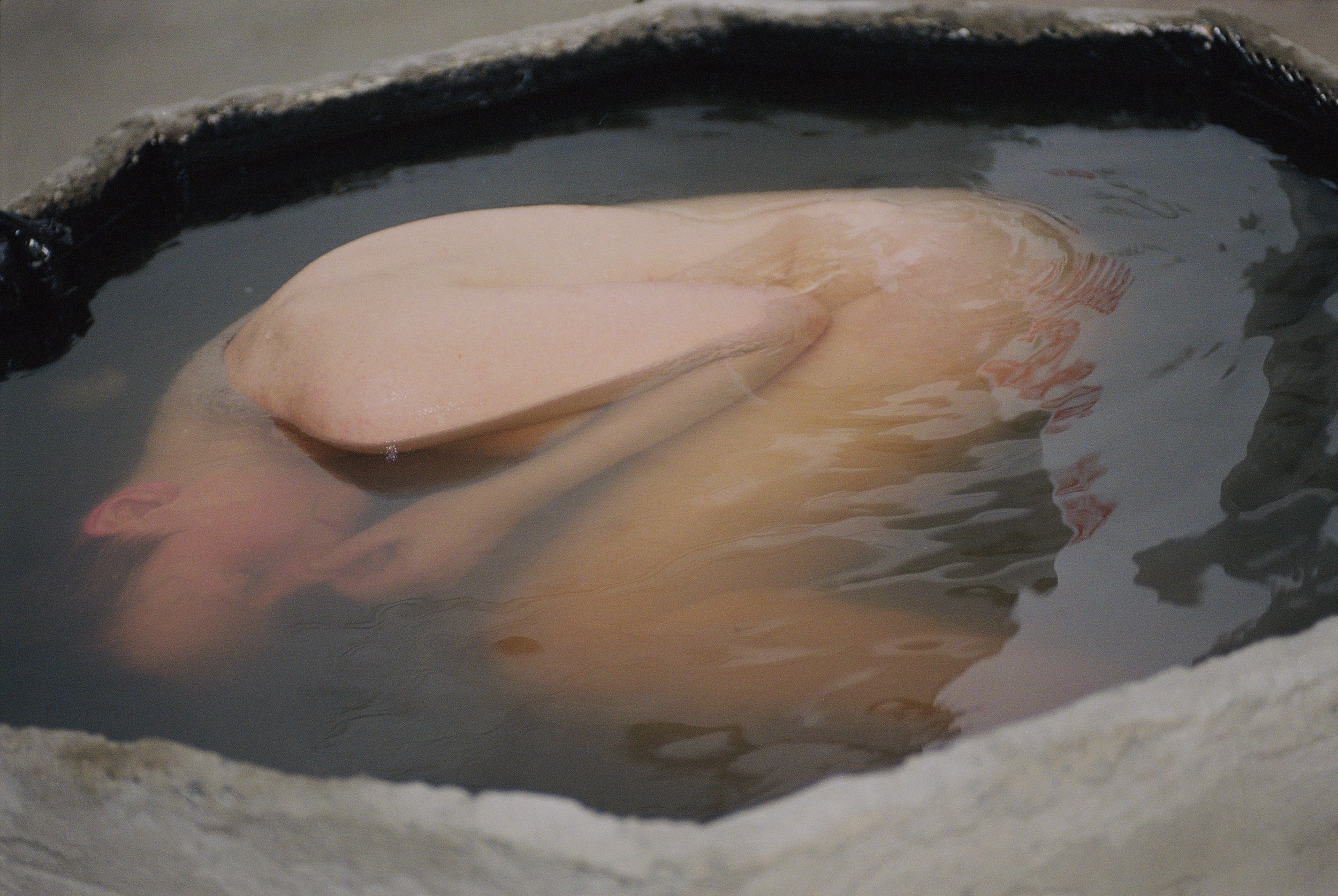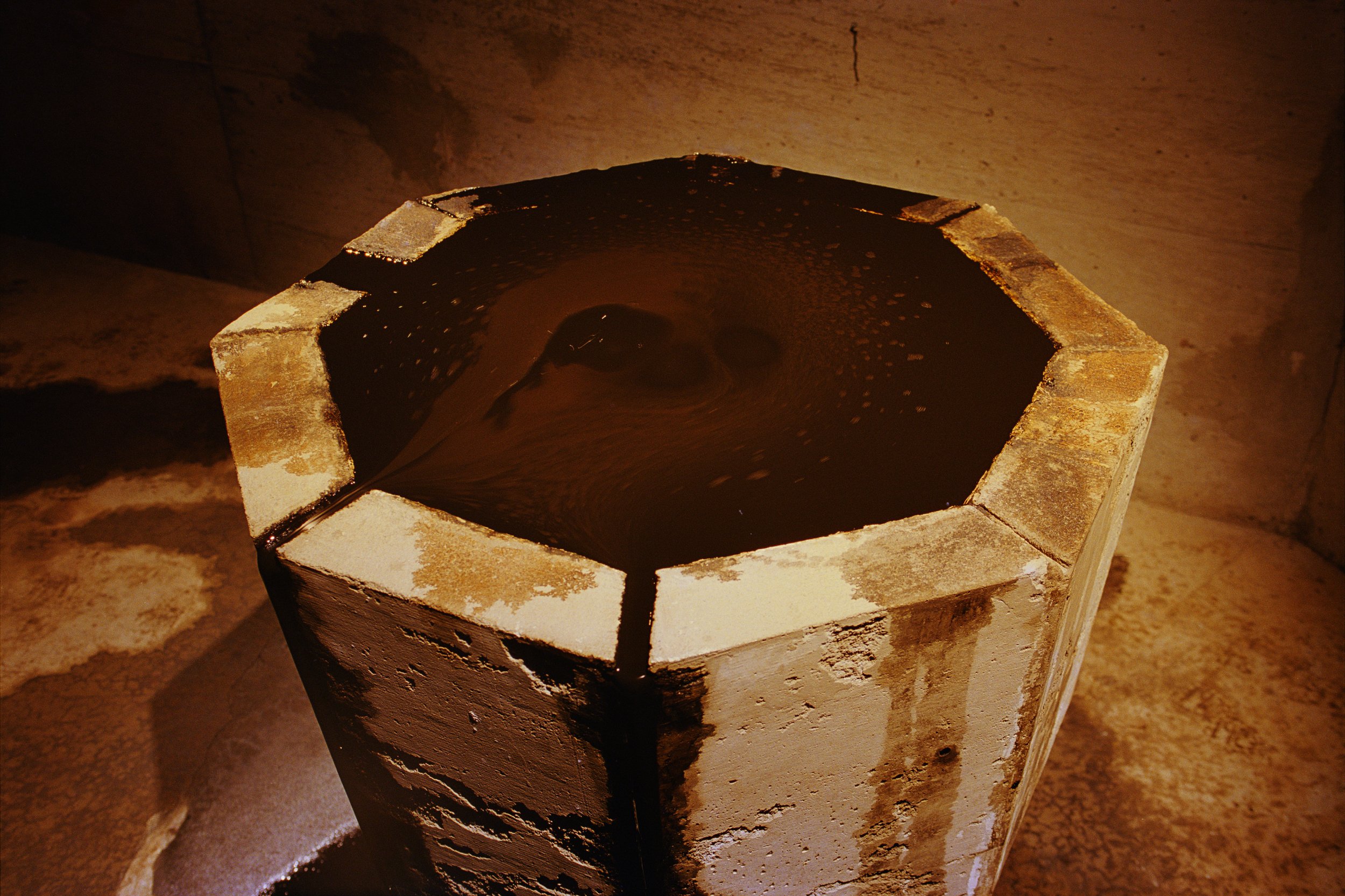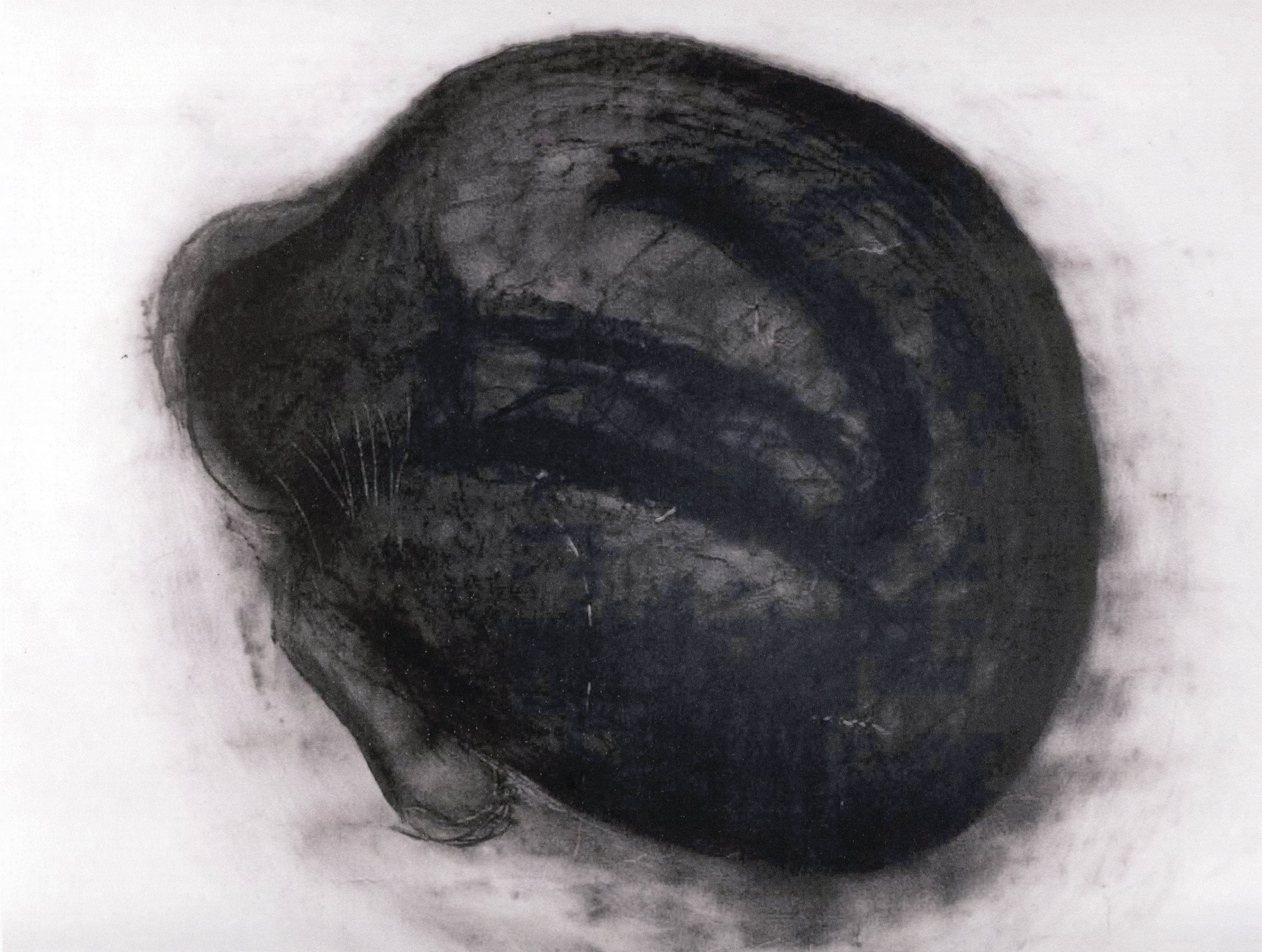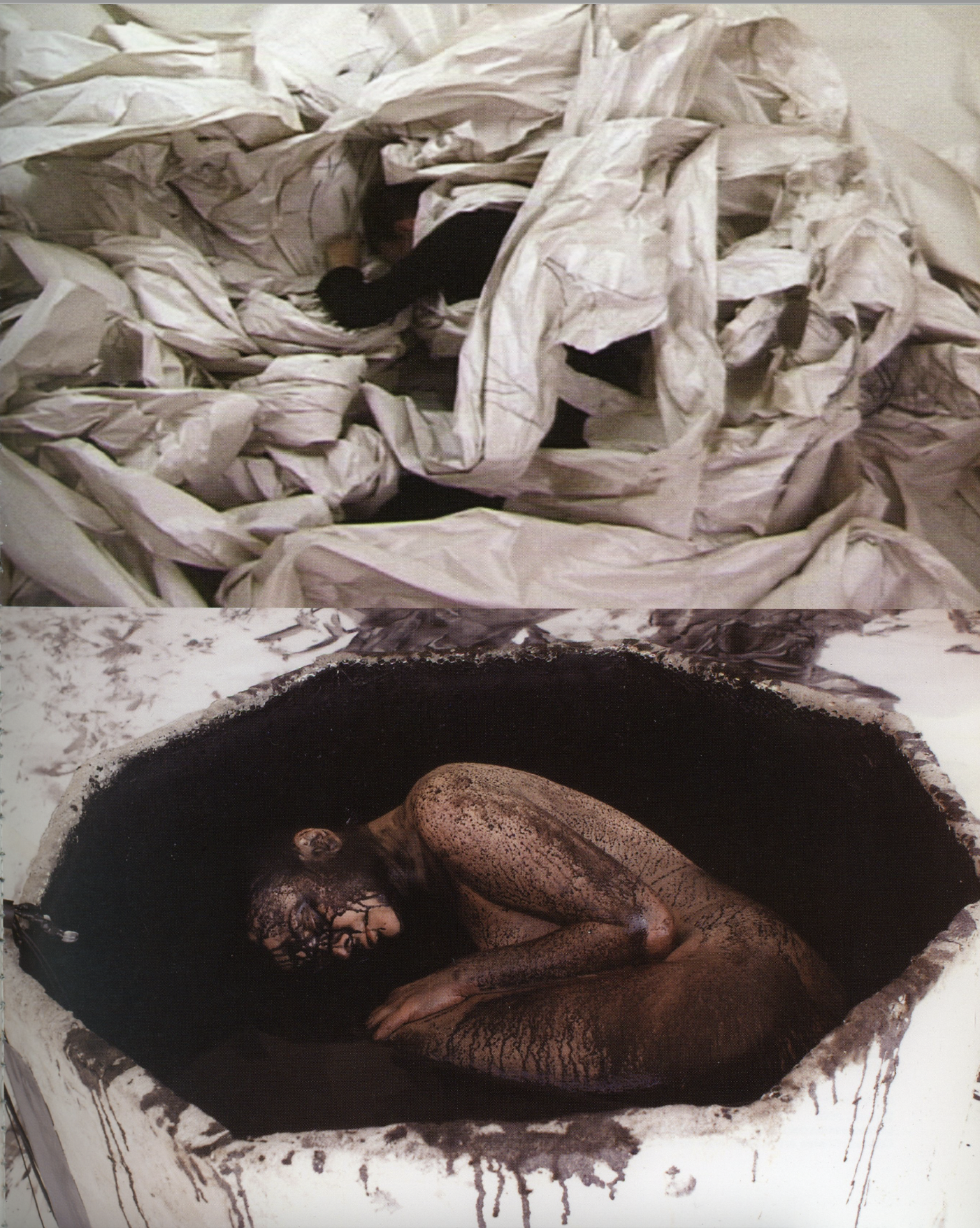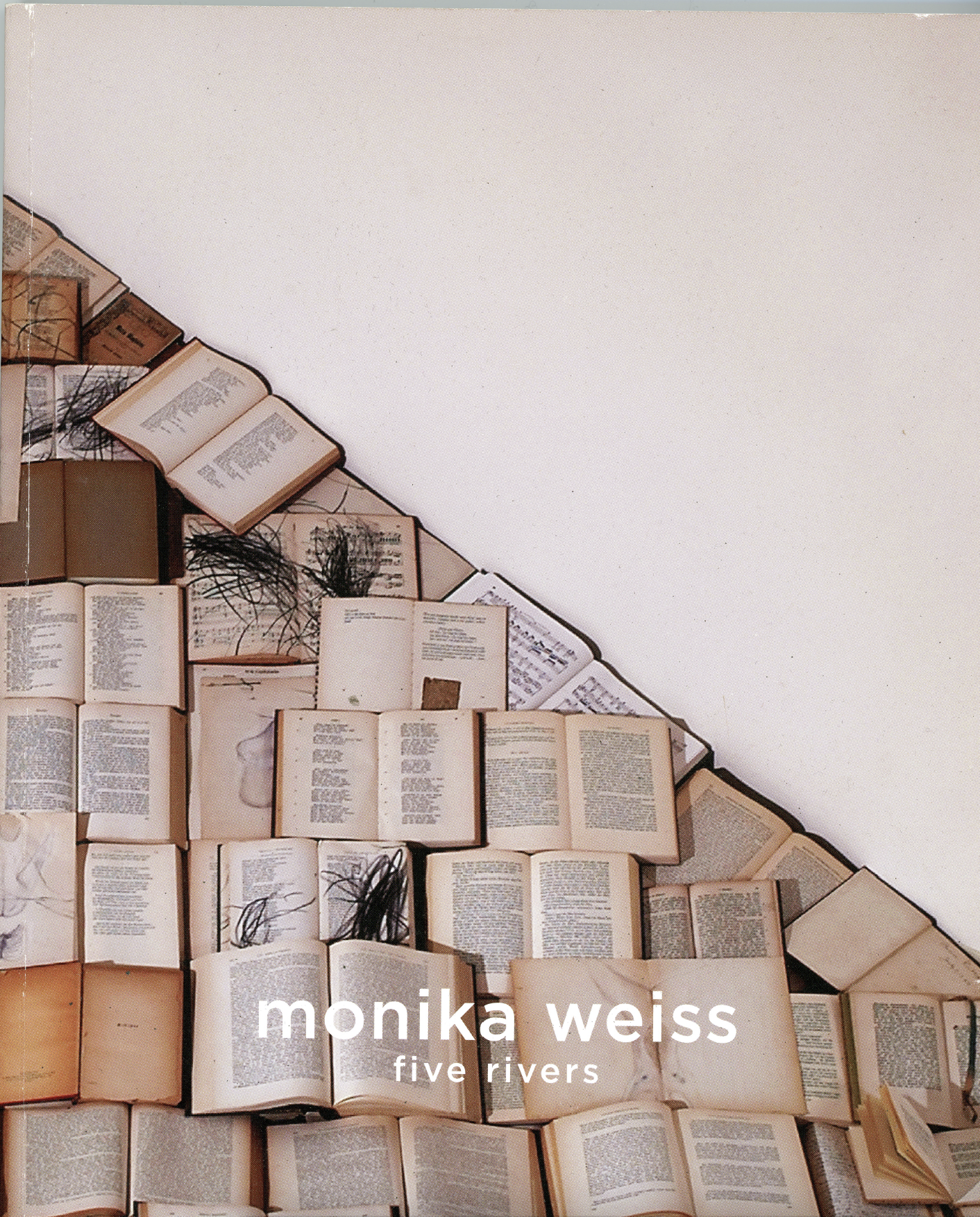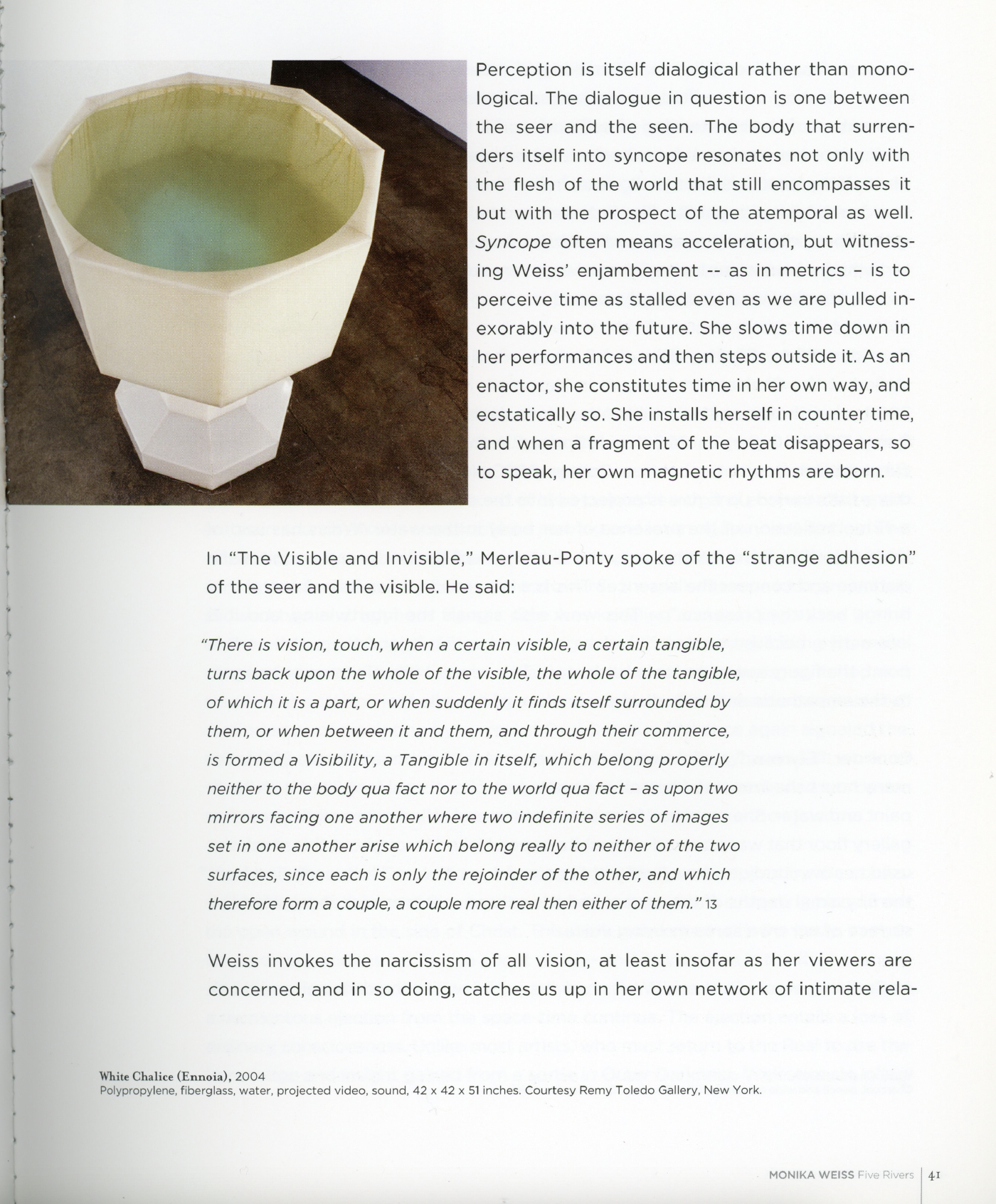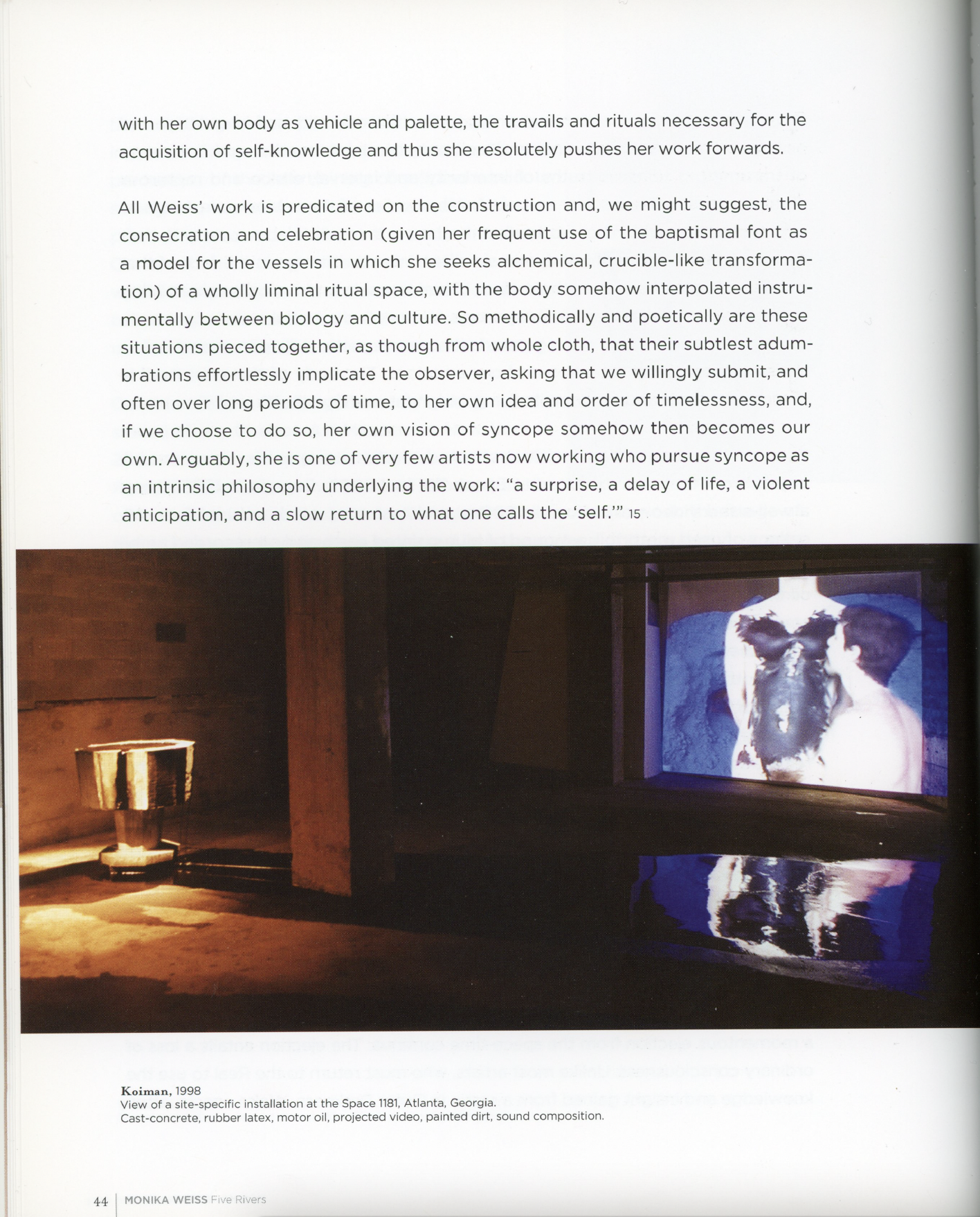James D. Campbell
Drawing on Syncope: The Performativity of Rapture in the Art of Monika Weiss
by James D. Campbell
in Monika Weiss: Five Rivers, Lehman College Art Gallery, City University of New York, and Galerie Samuel Lallouz, Montréal, 2007
"The romantic and clinical scenario has usually, in our society, been allotted to woman: it is she who sinks down, dress spreading out like a flower, fainting, before a public that hurries forward; arms reach out, carry the unresisting body... People slap her, make her sniff salts. When she comes to, her first words will be, "Where am I?" And because she has come to, "come back," no one thinks to ask where she has been. The real question would be, rather, "Where was I?" But no, when one returns from syncope it is the real world that suddenly looks strange."
- Catherine Clément, Syncope: The Philosophy of Rapture (1)
Polish-born, New York-based artist Monika Weiss practices, in her chosen media of drawing, performance, video, and installation, a restorative art of elision and ecstasy central to which is her own body and by extension, the body image of the observer. She draws on the syncope in order to ground her poetics of rapture in the specificity of the proverbial stop-time of the body and a corresponding lapse in ordinary consciousness. What may seem like a careful management of temporality in her work is really an attempt to step outside it. I mean, to step outside time. Suddenly, time falters.
In her work, the tremulous private body - her body and, by implication, my body - is best understood as a space "in between," a permeable membrane held taut between two polarities in the personae of two Muses, Mnemosyne and Lethe. She vanishes with alacrity into dark intervals and liminal spaces, often with witnesses present. Infinity opens up.
Her concern is with the osmosis and mirroring that result and she nurses interiority while negotiating the myriad interstices in the porous wall that stands between self and world. She constructs installations and enacts performances that relate thematically to these spaces-in- between and invites us to project ourselves into them so that we too, silently and alongside her, can better appreciate the perilous gap between absence of self and fragile self-presence, being straitjacketed by time and finding ourselves suddenly on the brink of timelessness, caught between the quotidian and the ecstatic. In all her work, she patiently draws on, draws in, draws out the syncope - and moves forward.
In medical discourse, 'syncope' (pronounced "sin-ko-pea") is the technical term for fainting. But whether fainting, elision, interval or absence, all relevant usages here, I use the term more specifically still as French psychoanalytic and feminist philosopher Catherine Clément does in her brilliant book Syncope: The Philosophy of Rapture, as that sudden lapse in consciousness when rapture is possible and the world becomes strange. Monika Weiss uses it in a strikingly similar way in her longstanding pursuit in art of elision and grace.
Clément seeks out syncope as unlikely paradigm and poetic metaphor in music, literature, psychoanalysis, philosophy - and, courageously, in life. She finds it in various physical mental, musical and more far-flung places: held breath, cold sweats, cerebral eclipse, epileptic seizure, delayed beats in a syncopated jazz rhythm, the backward dip in the Tango, orgasm and between urine and feces in Left-hand path Tantric ecstasy, and in a host of related phenomenon, she tabulates the sundry time-outs, disruptions, breaks in linearity and involuntary secessions from the space-time continua wherein syncope gains its foothold and human beings can achieve ecstasy.
In dilating on syncope as a temporary absence of self and birthplace of rapture, as Clément does, the phenomenon speaks eloquently to our embodiment - and to the work of Monika Weiss. If it delineates absence, it also brackets out and subverts the quotidian order of our lived reality, making its own persuasive case for subversion of norms and felt transcendence. The integers of absence, the strategic elisions and intervals into which subjectivity can disappear at a moment's notice, constitute the underpinnings of her project and, perhaps more importantly, its intrinsic ethics of overcoming and avowal.
When Clément argues that syncope has always been the enemy of Western philosophy - arguing that philosophers despise syncope and everything it represents - she specifies the reason for its suppression: hatred of the uncertainty so endemic to human life. As she says, "The history of our classical philosophy, as it is now taught, shows this: Western thought has been busy filling this hole in life. For a long time, it has worked desperately to include syncope in the realm of unfortunate accidents, sources of disorder, unhealthy disturbances..." (2) It makes sense. But syncope could not be kept in the box forever. Clément and Weiss are more in the Lacanian tradition, they live on the edge, in the interval, and theirs is really a strategic and reparative investigation of jouissance - of rapture, that is - understood in terms of the feminine and the lived-body.
Monika Weiss is a native of intervals. She identifies in her work the mostly unthematized lapses, gaps, ruptures, cracks and holes wherein rapture grows like a wild rose in the wasteland of the heart and pursues them thematically and in terms of her own embodiment. By using her own body and inserting it into syncope, employing it as primogenitary conduit between presence and absence, as it were, and speaking directly to the body of the observer in her performances and installations, she guarantees for her work a rare core of authenticity.
Consider the remarkable installation, Ennoia that was enacted at the Diapason Gallery in New York in 2002. The word Ennoia derives from the Greek (in the writings of Plato) and means "concept" and "a thought in mind." Weiss, who was inspired by Gnostic texts, said "I think of Ennoia as an edge of light, of consciousness, which collapsed into this world, into body, into darkness." (3)
The artist seemed to meld her own body to the contours of the water-filled sculpted basin in which it was submersed as though it were a secondary skin; a shell-like armature for her vulnerable body, providing protection. Like an embryo in vitro, the font was interpretable as exoskeleton containing a nourishing vat of amniotic fluid, replete with the waters of her life. Throughout the six-hour duration of the installation, the artist immersed herself in the water and periodically emerged from it. The basin resembled an octagonal medieval baptismal font. The image of her body curled up fetus-like within it was then projected on the proximate wall.
The "performance" - as in all such works by Weiss - is really more enactment than performance per se. There is no artifice whatsoever in the enactment. Weiss is not a "performance artist" in the traditional sense. First of all, her body embodies the syncope, and that body inhabits intervals that are her own as she dramatically represents the self in action and gesture but most importantly, she simply is. She achieves rapturous syncope in this movement of removal, within disappearance, and voluntarily in absentia .
Clément said, "This exceptional moment makes the surrounding world and its harsh laws disappear." (4) One such harsh and unyielding law is, of course, that of the temporal. Weiss has said of this work: "Water evokes in me a desire to immerse myself, to be away from the world and to hide in (and not from) disappearance." (5) Hiding in disappearance means inhabiting syncope, escaping from the constraints of linear time. By entering "the blessed syncope of supreme moments," artists and mystics escape the enervating constraints of these harsh laws and become "free, with an unreal and extraordinary sense of emancipation." (6)
This fluid shifting of the body in and out of time - which occurs frequently in her performances and usually at the height of syncope when ecstasy is hatched - is one wherein Weiss temporarily loses "the secured identity that constitutes (her) as a single member of the social body" Weiss deliberately embraces and works with the syncope as a way to unhinge herself from society and its timeline. She knows that, within its ambit is a horizon of meaning for a carnal subject and the prospect of rapture. (7) Weiss sees Ennoia as we do, as a poetic experiment in liminality, an experience of syncope, catalepsy, and ecstasy.
There is an analogy to be pursued between the structure of the ritual enactment and the model of syncope found in music. Interestingly, Weiss was originally trained as a musician. In conversation, Weiss said: "Syncope is to me also an important way of breaking the melody into another realm, transgressing the harmony and the rhythm in classical music." (8) In his Dictionary of Music, Jean-Jacques Rousseau formulated it as: " Syncope: prolongation on the strong (beat) of a sound begun on the weak (beat); wherefore, every syncopated note is in counter time and every collection of syncopated notes is a movement in counter time." (9) It is hard not to liken this to Weiss's movements whether drawing with her body on the floor or rising from and returning to the dark well. Clément said:
"The queen of rhythm, syncope is also the mother of dissonance; it is the source, in short, of a harmonious and productive discord. Attack and haven, collision; a fragment of the beat disappears, and of this disappearance, rhythm is born." (10) And, of course, Rousseau's dismantling of syncope into different moments of weak and strong beats is an unlikely forerunner of Lacan's "mirror phase," and a telling reference where Weiss's work is concerned. Why? Beyond the rhythms of movement, the dimension of sound in her installations is just as significant in forcing the limits of the self. (11)
Weiss's signature understanding of temporality bears a striking resemblance to that of the French philosopher Maurice Merleau-Ponty: a sense of time as an institution, a system of equivalences with infinite interstices. (12) Time is not an absolute series of events. Perception is itself dialogical rather than monological. The dialogue in question is one between the seer and the seen. The body that surrenders itself into syncope resonates not only with the flesh of the world that still encompasses it but with the prospect of the atemporal as well. Syncope often means acceleration, but witnessing Weiss's enjambement - as in metrics - is to perceive time as stalled even as we are pulled inexorably into the future. She slows time down in her performances - and then steps outside it. As an enactor, she constitutes time in her own way, and ecstatically so. She installs herself in counter time, and when a fragment of the beat disappears, so to speak, her own magnetic rhythms are born.
In The Visisble and Invisible, Merleau-Ponty spoke of the "strange adhesion" of the seer and the visible. He said:
“There is vision, touch, when a certain visible, a certain tangible, turns back upon the whole of the visible, the whole of the tangible, of which it is a part, or when suddenly it finds itself surrounded by them, or when between it and them, and through their commerce, is formed a Visibility, a Tangible in itself, which belong properly neither to the body qua fact nor to the world qua fact - as upon two mirrors facing one another where two indefinite series of images set in one another arise which belong really to neither of the two surfaces, since each is only the rejoinder of the other, and which therefore form a couple, a couple more real then either of them.” (13)
Weiss invokes the narcissism of all vision, at least insofar as her viewers are concerned, and in so doing, catches us up in her own network of intimate relations, making us complicit in the making of meaning, implicating us in a fluid, borderless, reciprocal perception of the intertwining of self and world. In seeing into her work, we see ourselves there in her place. We place ourselves, as it were, in her shoes. Our own bodies, caught like flies in amber and held within the spectacle, in a reciprocal insertion and intertwining of ourselves in the Other, always reminds us that Monika Weiss's is a deeply empathic art.
Consider White Chalice (Ennoia), 2004, which was installed at the Chelsea Art Museum in New York in 2004, also shown at the artist's New York dealer Remy Toledo Gallery in 2004 and reprised in the current exhibition at the Lehman College Art Gallery in 2005. In this work, the image of the artist's curled-up figure is projected into the surface of the water, now only a virtual reflection of the presence of her body in the water. Weiss has said of this work: "But if this earth is only the dispersion of the body, can we cross the distance and conquer the absence? This is a separation, a sensitive interval that brings back the presence." (14) This work also signals the intertwining, and it is interactive, because we see ourselves mirrored within it, and then, at a certain point, the figure seems to stare back at us. This reversibility alerts us once again to the empathetic and truly dialogical nature of her art.
Consider Elytron, 2003, performed at the Chelsea Art Museum in March, 2003. For many hours she immersed herself in an octagonal baptismal font filled with black paint and water. She emerged from time to time and rolled or crawled across the gallery floor that was covered with white paper. Naked throughout this ritual, she used her own body to draw, wet with its own ink, as it were, like a cephalod from the abyssmal depths of the ocean, and the subsequent traceries incarnated the surface of her own soma as living voice.
As Carl Jung would have said, Weiss had stepped down to the dark well and drank deep of its restorative waters, returning to the lifeworld with self-knowledge and new-found powers of endurance and testimony. Her performative work is a means of transmitting timeless truths of interiority and interval, elision and rapturous presence to her viewers. Her respect for the bodies of those viewers extends to embracing them within her work, whether sharing in creative labour, party to their mirroring there or insisting they remain silent, intent witnesses in the face of that creation.
Monika Weiss uses the surface of her own skin as drawing brush, as living elision, fluid boundary, rapturous syncope. We never doubt the stakes, for her, in so doing, and her radiant courage exerts its own magnetic pull upon us and stakes its own claim on our attention and our emotions. The body of the artist itself is protagonist here; and syncope its living, poignant primogeniture.
Consider Koiman, 1998, an ambitious mixed media site-specific video-sound-object work that was exhibited at Space 1181 in Atlanta, Georgia in 1998. Using a wall-sized video-projection, an 800-pound cast-concrete baptismal font, 60 gallons of used motor oil, a mound of blue-painted earth and prerecorded ambient train sounds, Weiss constructed a moving and interrogatory installation. The oil continuously overflowed the rim of the vessel, and the river of oil issued forth across the slanted gallery floor and led towards the wall where a video projection showed two androgynous figures. One was kneeling and suckling at the breast of the other, as though licking tarry, coagulated life's blood dribbling from the nipple of a breast.
The constant overlaid soundtrack of trains being switched and shunted at a station lent a haunting audio complement to the eerie tableaux that reminded us of a painting by surrealist Paul Delvaux and once again signaled the necessary role of sound in Weiss's work. In this powerfully synaesthetic work, in which all the senses were implicated, Weiss once again demonstrated her desire to breach all boundaries, dislocate the time sense and invoke the syncope.
Koiman (from the Greek "to put to sleep to coffin") was inspired by the confessions of Saint Catherine of Sienna, who claimed to have drunk sustaining blood from the open wound in the side of Christ. This work, concerned with the body, vampirism, memory and the self is also about ritual - and its intention is to effect a wholesale disruption of the condition of being here in the lifeworld. Syncope entails such a momentous ejection from the space-time continua. The ejection entails a loss of ordinary consciousness. Unlike most artists, who must return to the Real to use the knowledge and insight gained from a sortie in Outer Darkness, Weiss enacts, often with her own body as vehicle and palette, the travails and rituals necessary for the acquisition of self-knowledge and thus she resolutely pushes her work forwards.
All Weiss's work is predicated on the construction and, we might suggest, the consecration and celebration (given her frequent use of the baptismal font as a model for the vessels in which she seeks alchemical, crucible-like transformation) of a wholly liminal ritual space, with the body somehow interpolated instrumentally between biology and culture. So methodically and poetically are these situations pieced together, as though from whole cloth, that their subtlest adumbrations effortlessly implicate the observer, asking that we willingly submit, and often over long periods of time, to her own idea and order of timelessness, and, if we choose to do so, her own vision of syncope somehow then becomes our own. Arguably, she is one of very few artists now working who pursue syncope as an intrinsic philosophy underlying the work: "a surprise, a delay of life, a violent anticipation, and a slow return to what one calls the 'self'." (15)
The rapture she feels so intensely may be accessible to us as well, if and when we give ourselves over completely to the claim the work stakes upon us. The subsequent understanding not only of her intention but the level of our own engagement with that work convinces us not only of the analeptic nature of the syncope but the very real possibilities her installations offer for extracting ourselves from the progressive order of linear time - and immersing ourselves in the spaces in between. In placing ourselves apart, mute but never more optically and imaginatively alive, we commune with her in syncope.
Weiss's syncopating rhythms both disrupt and, paradoxically, prolong time. In performance, her repetition and syncopation possesses a powerful magnetism that means not turning away but attending to it over time, with intensity and avowal. Her work has a radical disconnect built-in that holds us in a trancelike, hypnotic state. Syncope is also a little death, but the self needs to die in fractional ways in order that it might live. Weiss wants to cross boundaries and subvert from within. Death is close, she seems to say, but the affirmation of what it is to be alive is even closer.
Syncope also lives in the artist's magnificent drawings, which are the touchstone of her art. Speaking of the many drawings she has executed over the last few years, the intimacy and anguished charisma of which can reduce us to tears in a heartbeat, she speaks of the legion of traces and syncopated gestures left behind in those works. The charcoal marks always point to the body, her body, our body, and they are living "intervals of time". They have no stasis in them. When Clément asks, "Where is the lost syllable, the beat eaten away by the rhythm? Where does the subject go who later comes to, 'comes back?' Where am I in syncope?" (16) Weiss would probably say "Inside my work, in the drawn mark. That is where I live and think and bleed." For it is in the trace of soma, the memory trace and the residue of the body's arc-like trajectory across the numinous interval, the absence, the gap, and the remnants of all manner of possible worlds long since extinguished, that being still resides.
Weiss understands the lived-body as passage, threshold, pure liminality, and permeable membrane when she finds herself willfully waylaid in her own work, retracing her own perilous trajectory from birth to where she is now. "Where am I in syncope?" is a question she has asked herself time and time again, and if the answer still eludes her, it is because there is always another drawing to execute, another installation to conceive, another performance to enact. Where does the self find itself in the folklore of the moment, rife with memory traces, in that tense and unfathomable interval between interiority and exteriority, between living and dying, past and present?
The self is segregated in its time-stream but also irremediably wed to a temporality that is, by nature, inimical and the body is subject to its perennial rites of attrition. Monika Weiss acts as witness to that attrition even as she, in ritual and repetitive acts, escapes for a time the humbling stream of real duration, and in stepping outside it, shows us all how a self might inhabit a break in linearity and make it her own - a place to be and think within, perhaps? Where is she in syncope? Certainly, outside the comforting predictability of the mainstream, outside the stream of a physical time which never stops. She is on the lip of the dark well. On the precipice, where there is no safe harbor, and only hazard as fissures open up all around in the fabric of certainty, and the self must bow irrevocably earthwards to the darkness in its own nature.
Weiss has over the years executed an extensive corpus of drawings. She has said, "I position the human body outside time or defined space." (17) She is literally drawing a radius across the full breadth of syncope in these works with her own aging body as sector, alembic and divining rod, as though possessed by its own carnal geometry, tracing out the luminous grid of the interval, the "moments in and out of time" across the full array of the sensible of which she is so ineluctably a part.
In her drawing she is just as aware of the reversibility of the seeing and the visible, of the touching and the touched, as in all of her other work. Her large-scale drawings in a continuing series of harrowing representations of her own body in a curled-up or standing positions, shadows on the face of the deep, invoke and provoke the reversibility which is integral to her manner of working, whatever the medium, and are always predicated on the medium of her own body as best conduit of expression and shifting shadow between the visible and the invisible, the seer and the seen.
Consider the ecstatic Milk Series, 2001, exhibited at Galerie Samuel Lallouz in Montréal in 2005 and in this exhibition at the Lehman College Art Gallery, a series of small-scale drawings executed with pencil, crayon, milk, cream and hair-dye. These drawings reference the concept of fluidity that is so central to her work. As she says, "Fluids have no boundaries and as such they connote the lack of boundaries between the self, the body and the world." (18)
Consider Skulenie, 2003, a particularly haunting charcoal drawing on photographic backdrop paper. And what haunts us? What haunts us is the memory of the artist's presence impressed on the ground, the seductive traceries of her touch and the raw physical labor and imaginative toil in the making. The syncope haunts us even as it instructs us in its subversive anarchy, in its refusal to yield to the time-binding oral culture. As Clément said: "Syncope is resistance, rebellion, rejection of the world and the dissolution of the subject... But we must go further to understand why no creation is possible without the syncope of the subject. From then on signs - clearly apparent - of a remarkable return of the past in the present begin to change meaning and appearance." (19)
Monika Weiss's remarkable attempt to bevel the rough edges of consciousness and to make us more supple, more receptive and more sensitive to the hermeneutics of her open work, to win freedom from time and from the hegemony and tyranny of the sign, is always deeply moving, has powerful authenticity and is, above all, that rarest of things, a genuine epiphany in the ever- darkening and restless waters of contemporary art.
James D. Campbell, Montréal, 2005
Notes:
[1] Catherine Clément. Syncope: The Philosophy of Rapture. Translated by S. O'Driscoll and D.M.Mahoney.(Minneapolis: University of Minnesota Press, 1994). p. 1.
[2] Ibid., pp. 20-21.
[3] Monika Weiss, "Statement," N.p. n.d.
[4] Clément, p. 175
[5] Monika Weis, "Statement," N.p, n.d.
[6] Clément, p. 240.
[7] Ibid., p. 240.
[8] Monika Weiss, communication to the author, June 29, 2005.
[9] Clément, p. 254
[10] Clément, p. 5.
[11] Clément, p. 256.
[12] Maurice Merleau-Ponty, The Visible and the Invisible. Translated by Alphonso Lingis. (Evanston, Ill.: Northwestern University Press, 1968), p. 184.
[13] Merleau-Ponty, Ibid, p. 147.
[14] Monika Weiss, "Statement" N.p., n.d.
[15] Clément, p. 21.
[16] Clément, p. 5.
[1]. Monika Weiss, "Statement" N.p., n.d.
[18] Monika Weiss, "Statement," N.p. n.d.
[19] Clément, p. 236.
